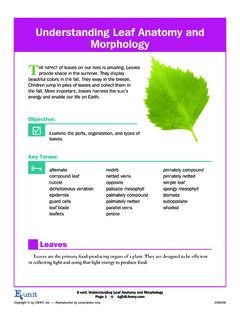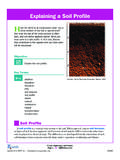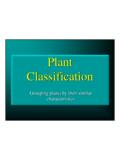Transcription of Understanding Leaf Anatomy and Morphology
1 Understanding Leaf Anatomy andMorphologyTHE IMPACTof leaves on our lives is amazing. Leavesprovide shade in the summer. They displaybeautiful colors in the fall. They sway in the jump in piles of leaves and collect them inthe fall. More important, leaves harness the sun senergy and enable our life on : Examine the parts, organization, and types Terms: LeavesLeaves are the primary food-producing organs of a plant. They are designed to be efficientin collecting light and using that light energy to produce : Understanding Leaf Anatomy and MorphologyPage by CAERT, Inc. Reproduction by subscription leafcuticledichotomous venationepidermisguard cellsleaf bladeleafletsmidribnetted veinsoppositepalisade mesophyllpalmately compoundpalmately nettedparallel veinspetiolepinnately compoundpinnately nettedsimple leafspongy mesophyllstomatasuboppositewhorledPARTS OF A LEAFThe main light-collecting structure on a leaf is a large, broad, flat surface called theleafblade.
2 The blade has many layers that not only help the plant move but also help it storematerials and byproducts of photosynthesis. The blade is held away from the stem and sup-ported by thepetiole. The petiole is not exactly like a stem, but it does have xylem andphloem that transport water and blade is supported by a system of veins that also contain both xylem and phloem. Theseveins prevent the blade from collapsing under its own weight. A leaf is often organized withone main vein running down the middle of the blade. This vein is called themidrib. All of theveins, the petiole, and the midrib help position the blade so that it is facing the light of flowering plants are found in several patterns. Monocots and dicots have have leaves withparallel the veins may not be parallel in a strictmathematical sense, none of the veins on a monocot leaf cross. They may look as if they arefused together at the top or bottom of the blade.
3 Corn and grass plants are good examples : Understanding Leaf Anatomy and MorphologyPage by CAERT, Inc. Reproduction by subscription 1. The major parts of a have leaves with veins that connect and branch from each other. Veins in a branch-ing pattern are callednetted veins. A leaf with netted veins sometimes has several smallerveins branching out of a dominant midrib, a condition known aspinnately netted. Elmsand oaks have pinnate netting. A leaf may sometimes have several dominant veins branchingout from the petiole. This condition, known aspalmately netted, is common with maplesand few plants have a spreading vein pattern calleddichotomous venation. A gingko leafhas veins of this ORGANIZATIONA leaf is organized to collect sunlight. The leaf blade is constructed of many layers thatmake this top of the leaf is a waxy, noncellular layer called thecuticle. The cuticle is on the leafto prevent water from escaping.
4 Generally speaking, plants that live in bright, arid conditionshave very thick cuticle next layer on the leaf isalso there for protection. Theepidermisis the skinlike layer ofcells found on both the top andbottom surfaces of the leaf. Theepidermis may be one or manylayers beneath the upperepidermis is a layer of cells thatare standing on end and packedvery tightly. These standing cellsE-unit: Understanding Leaf Anatomy and MorphologyPage by CAERT, Inc. Reproduction by subscription venationPalmatelynetted venationDichotomousvenationFIGURE 2. Leaf venation epidermisLower epidermisPalisadeSpongyXylemPhloemMesoph yllVeinStoma}}}}FIGURE 3. A cross section of a responsible for most of the photosynthesis in the leaf and are called under the palisade mesophyll are loosely packed cells called the spongy mesophyllforms air spaces that hold raw materials to be used and products lower epidermis on the bottom of the leaf has holes in it for gas exchange.
5 The holesare calledstomata(singular: stoma), and they can open and close. The opening and closing iscontrolled by a pair ofguard cells , which surround each OF LEAVEST here are many different types of leaves. Some leaves are adapted to hot, dry climates bybeing able to store water or being smaller. Some leaves have very large blades to collect themaximum light in a shady location. The blades of some leaves are broken into three or leaf that has only one blade on its petiole is called asimple leaf. Most plants have sim-ple leaf that has multiple blades, orleaflets, is called acompound leaf. There are differ-ent kinds of compound leaves. Two common types are the palmately compound leaf and thepinnately compound leaf. Apalmately compoundleaf has all its leaflets attached to a com-mon point. Apinnately compoundleaf has multiple leaflets attached along a rachis, or : Understanding Leaf Anatomy and MorphologyPage by CAERT, Inc.
6 Reproduction by subscription 4. Types of leavesLEAF ARRANGEMENTL eaves are arranged along a stem in one of four major ways. When leaves and buds aredirectly across from each other on a stem, they are said to beopposite. Leaves and budsspaced along a stem in an alternating fashion are termedalternate. Another arrangement issubopposite, in which leaves and buds are not spaced far enough apart to be called alternate,but neither are they perfectly opposite. When three or more leaves and buds are attached at anode, the arrangement is :2 Leaves are the primary food-producing organs of a plant. The main light-collectingstructure on a leaf is a large, broad, flat surface called the leaf blade. The blade isheld away from the stem and supported by the have leaves with parallel veins. Dicots have leaves with veins that connectand branch from each other. Veins in a branching pattern are called netted cross section of a leaf blade reveals a layer of cuticle covering a layer of epidermalcells.
7 Beneath the upper epidermis are a layer of standing cells called the palisademesophyll and a layer of loosely packed cells called the spongy mesophyll. Thelower epidermis is on the bottom of the leaf. It has holes called stomata that canopen and close. The opening and closing is controlled by a pair of guard : Understanding Leaf Anatomy and MorphologyPage by CAERT, Inc. Reproduction by subscription 5. Types of leaf arrangements on leaf that has only one blade on its petiole is called a simple leaf. A leaf that hasmultiple blades is called a compound leaf. Two common types of compound leavesare the palmately compound leaf and the pinnately compound are arranged along a stem in one of four major ways. They may be opposite,alternate, subopposite, or Your Knowledge: 1. What are the main parts of a leaf?2. How do vein patterns on leaves differ?3. How is a leaf organized?4.
8 What are the types of leaves?5. What are the four major leaf arrangements?Expanding Your Knowledge:LCollect specimens from trees and shrubs in your area. For each, determine the typeof leaf and the arrangement of the leaves on the stem. Use this knowledge to iden-tify each plant. Use a dichotomous key if it is Links::Plant ~lthompson/bgy34/ : Understanding Leaf Anatomy and MorphologyPage by CAERT, Inc. Reproduction by subscription












